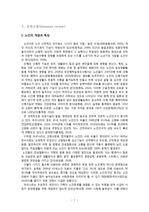

PARTNER
검증된 파트너 제휴사 자료
여성 노인에서 운동 수행능력과 골밀도의 관계 (Association Between Physical Performance and Bone Mineral Density in Elderly Women)
6 페이지
최초등록일 2025.03.20
최종저작일
2009.12

-
서지정보
· 발행기관 : 대한물리치료학회
· 수록지 정보 : 대한물리치료학회지 / 21권 / 4호 / 37 ~ 42페이지
· 저자명 : 신화경, 조광호
초록
Purpose: The purpose of this study was to determine the effect of physical performance on bone mineral density (BMD) in elderly women.
Methods: Twenty-one elderly women participated in this study. After testing functional ambulation category (FAC), they were classified into two groups: dependent walking group, those who could not walk independently (FAC 0~2, n=11) and independent walking group those who could walk independently (FAC 3~5, n=10). Outcome measures were: general characteristics, physical performance and BMD. General characteristics included age, body mass index (BMI) and waist-hip ratio. Physical performance included the chair rise test (CRT) and the modified fall efficacy scale (MFES). BMD was represented in the osteoporosis index (OI), T-score and Z-score. BMD was evaluated in calcaneal bone, using OsteoPro. The data was analyzed using SPSS 12.0 software and the Mann-Whitney U test and the Spearman correlation.
Results: Age, BMI and waist hip ratio, which all affect BMD, showed no significant differences between groups (p>0.05). But the FAC 3~5 group showed a significantly higher score for CRT, MFES and T-score, compared with the FAC 0~2 group (p<0.05). The T-score was correlated with CRT and MFES scores (p<0.05).
Conclusion: There is a positive relationship between physical performance and BMD. Therefore, improved physical performance can have a beneficial effect by reducing osteoporosis in elderly women, considering a positive relationship between physical performance and BMD.영어초록
Purpose: The purpose of this study was to determine the effect of physical performance on bone mineral density (BMD) in elderly women.
Methods: Twenty-one elderly women participated in this study. After testing functional ambulation category (FAC), they were classified into two groups: dependent walking group, those who could not walk independently (FAC 0~2, n=11) and independent walking group those who could walk independently (FAC 3~5, n=10). Outcome measures were: general characteristics, physical performance and BMD. General characteristics included age, body mass index (BMI) and waist-hip ratio. Physical performance included the chair rise test (CRT) and the modified fall efficacy scale (MFES). BMD was represented in the osteoporosis index (OI), T-score and Z-score. BMD was evaluated in calcaneal bone, using OsteoPro. The data was analyzed using SPSS 12.0 software and the Mann-Whitney U test and the Spearman correlation.
Results: Age, BMI and waist hip ratio, which all affect BMD, showed no significant differences between groups (p>0.05). But the FAC 3~5 group showed a significantly higher score for CRT, MFES and T-score, compared with the FAC 0~2 group (p<0.05). The T-score was correlated with CRT and MFES scores (p<0.05).
Conclusion: There is a positive relationship between physical performance and BMD. Therefore, improved physical performance can have a beneficial effect by reducing osteoporosis in elderly women, considering a positive relationship between physical performance and BMD.참고자료
· 없음태그
-
자료후기
-
자주묻는질문의 답변을 확인해 주세요

꼭 알아주세요
-
자료의 정보 및 내용의 진실성에 대하여 해피캠퍼스는 보증하지 않으며, 해당 정보 및 게시물 저작권과 기타 법적 책임은 자료 등록자에게 있습니다.
자료 및 게시물 내용의 불법적 이용, 무단 전재∙배포는 금지되어 있습니다.
저작권침해, 명예훼손 등 분쟁 요소 발견 시 고객센터의 저작권침해 신고센터를 이용해 주시기 바랍니다. -
해피캠퍼스는 구매자와 판매자 모두가 만족하는 서비스가 되도록 노력하고 있으며, 아래의 4가지 자료환불 조건을 꼭 확인해주시기 바랍니다.
파일오류 중복자료 저작권 없음 설명과 실제 내용 불일치 파일의 다운로드가 제대로 되지 않거나 파일형식에 맞는 프로그램으로 정상 작동하지 않는 경우 다른 자료와 70% 이상 내용이 일치하는 경우 (중복임을 확인할 수 있는 근거 필요함) 인터넷의 다른 사이트, 연구기관, 학교, 서적 등의 자료를 도용한 경우 자료의 설명과 실제 자료의 내용이 일치하지 않는 경우
“대한물리치료학회지”의 다른 논문도 확인해 보세요!
-
저강도 초음파가 흰쥐 대퇴골 골절치유와 TGF-β1의 발현에 미치는 영향 6 페이지
Purpose: The purpose of this study was to investigate the effects of low intensity pulsed ultrasound on TGF-β1 expression and healing of rat femur penetrating fractures. Methods: Rats were anesthetize.. -
경두개 직류전류 자극이 대뇌피질의 뇌 활성도에 미치는 영향 7 페이지
Purpose: Recent numerous neurostimulation studies for manipulating the cortical excitability of human brain have been increasingly attempted. We investigated whether transcranial direct current stimul.. -
양극 경두개직류자극에 의한 운동관련피질전위의 변화 7 페이지
Purpose: Transcranial direct current stimulation (tDCS) is a useful method for modulating the brain activity. This study compared the effect of continuous and interrupted tDCS using the change in the .. -
긴장성 두통에 대한 두개경부 운동의 효과 8 페이지
Purpose: This study was done to assess the effect of changes in forward head posture (FHP), neck mobility and headache clinical parameters on episodic tension-type headache (ETTH) and chronic tension-..
찾으시던 자료가 아닌가요?
지금 보는 자료와 연관되어 있어요!
문서 초안을 생성해주는 EasyAI



